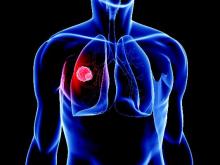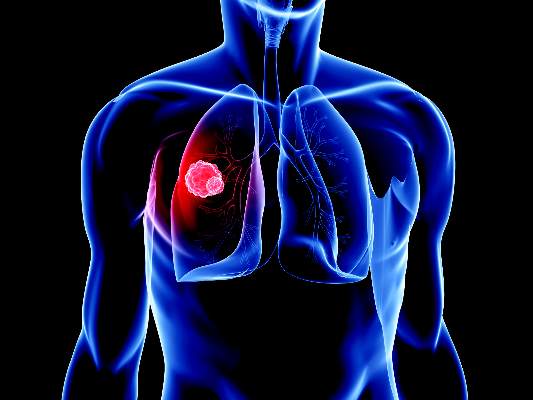User login
The prevalence of mutations in oncogenic driver genes is correlated to smoking dose and body mass index, according to a prospective epidemiology study of environmental factors and mutation frequencies in non–small-cell lung cancer that was published online May 9.
In the Japan Molecular Epidemiology for Lung Cancer study, Dr. Tomoya Kawaguchi and colleagues found that increased mutation frequencies in TP53, KRAS, and NFE2L2 correlated with smoking dose (P < .001 for all), whereas decreased mutation frequencies were observed in EGFR (P < .001) and CTNNB1 (P = .030). The number of KRAS mutations in smokers increased in proportion to body-mass index (BMI) increases (P = .026).
Simultaneous mutations in EGFR and CTNNB1 suggested possible biological relevance; 88% of CTNNB1 mutations (15/17) occurred with EGFR mutations. TP53 and NFE2L2 mutations were more frequent in advanced-stage disease, wrote Dr. Kawaguchi of the department of respiratory medicine at Osaka (Japan) City University and colleagues (J Clin Oncol. 2016 May 9. doi: 10.1200/JCO.2015.64.2322).
Although smoking is the most studied cause of lung cancer, about one-quarter of lung cancers worldwide occur in never-smokers.“It remains elusive which environmental factors contribute to the EGFR mutations that are frequently observed in never-smokers,” the investigators wrote. “In this study, the prevalence of EGFR mutations was higher in those who had more [environmental tobacco smoke], although this difference did not reach the level of statistical significance in the sample size. More detailed methods to detect the mutations (e.g., digital polymerase chain reaction) might yield more precise information.”
Levels of sex hormones were not significant factors in mutation frequencies, but the investigators found that estrogen receptor was more highly expressed in never-smokers than smokers, and the presence of estrogen receptor was associated with EGFR mutations in younger patients.
The investigators studied environmental influences on lung cancer by collecting information by questionnaire and by detecting mutations in 72 candidate genes from 876 patients with stage I to IIIB non–small-cell lung cancer (441 ever- and 435 never-smokers). In total, 622 patients had at least one mutation, and 860 mutations were observed. Dr. Kawaguchi and colleagues also examined patterns of estrogen-receptor expression by immunohistochemical staining and evidence of human papillomavirus (HPV) infection by a polymerase chain reaction–based microarray system.
Contrary to retrospective analyses that had pointed to a link between HPV and NSCLC, this prospective study showed little evidence for HPV in early NSCLC.
Dr. Kawaguchi reported having financial ties to Chugai Pharmaceutical and Eli Lilly. Several coauthors reported tis to industry sources.
The prevalence of mutations in oncogenic driver genes is correlated to smoking dose and body mass index, according to a prospective epidemiology study of environmental factors and mutation frequencies in non–small-cell lung cancer that was published online May 9.
In the Japan Molecular Epidemiology for Lung Cancer study, Dr. Tomoya Kawaguchi and colleagues found that increased mutation frequencies in TP53, KRAS, and NFE2L2 correlated with smoking dose (P < .001 for all), whereas decreased mutation frequencies were observed in EGFR (P < .001) and CTNNB1 (P = .030). The number of KRAS mutations in smokers increased in proportion to body-mass index (BMI) increases (P = .026).
Simultaneous mutations in EGFR and CTNNB1 suggested possible biological relevance; 88% of CTNNB1 mutations (15/17) occurred with EGFR mutations. TP53 and NFE2L2 mutations were more frequent in advanced-stage disease, wrote Dr. Kawaguchi of the department of respiratory medicine at Osaka (Japan) City University and colleagues (J Clin Oncol. 2016 May 9. doi: 10.1200/JCO.2015.64.2322).
Although smoking is the most studied cause of lung cancer, about one-quarter of lung cancers worldwide occur in never-smokers.“It remains elusive which environmental factors contribute to the EGFR mutations that are frequently observed in never-smokers,” the investigators wrote. “In this study, the prevalence of EGFR mutations was higher in those who had more [environmental tobacco smoke], although this difference did not reach the level of statistical significance in the sample size. More detailed methods to detect the mutations (e.g., digital polymerase chain reaction) might yield more precise information.”
Levels of sex hormones were not significant factors in mutation frequencies, but the investigators found that estrogen receptor was more highly expressed in never-smokers than smokers, and the presence of estrogen receptor was associated with EGFR mutations in younger patients.
The investigators studied environmental influences on lung cancer by collecting information by questionnaire and by detecting mutations in 72 candidate genes from 876 patients with stage I to IIIB non–small-cell lung cancer (441 ever- and 435 never-smokers). In total, 622 patients had at least one mutation, and 860 mutations were observed. Dr. Kawaguchi and colleagues also examined patterns of estrogen-receptor expression by immunohistochemical staining and evidence of human papillomavirus (HPV) infection by a polymerase chain reaction–based microarray system.
Contrary to retrospective analyses that had pointed to a link between HPV and NSCLC, this prospective study showed little evidence for HPV in early NSCLC.
Dr. Kawaguchi reported having financial ties to Chugai Pharmaceutical and Eli Lilly. Several coauthors reported tis to industry sources.
The prevalence of mutations in oncogenic driver genes is correlated to smoking dose and body mass index, according to a prospective epidemiology study of environmental factors and mutation frequencies in non–small-cell lung cancer that was published online May 9.
In the Japan Molecular Epidemiology for Lung Cancer study, Dr. Tomoya Kawaguchi and colleagues found that increased mutation frequencies in TP53, KRAS, and NFE2L2 correlated with smoking dose (P < .001 for all), whereas decreased mutation frequencies were observed in EGFR (P < .001) and CTNNB1 (P = .030). The number of KRAS mutations in smokers increased in proportion to body-mass index (BMI) increases (P = .026).
Simultaneous mutations in EGFR and CTNNB1 suggested possible biological relevance; 88% of CTNNB1 mutations (15/17) occurred with EGFR mutations. TP53 and NFE2L2 mutations were more frequent in advanced-stage disease, wrote Dr. Kawaguchi of the department of respiratory medicine at Osaka (Japan) City University and colleagues (J Clin Oncol. 2016 May 9. doi: 10.1200/JCO.2015.64.2322).
Although smoking is the most studied cause of lung cancer, about one-quarter of lung cancers worldwide occur in never-smokers.“It remains elusive which environmental factors contribute to the EGFR mutations that are frequently observed in never-smokers,” the investigators wrote. “In this study, the prevalence of EGFR mutations was higher in those who had more [environmental tobacco smoke], although this difference did not reach the level of statistical significance in the sample size. More detailed methods to detect the mutations (e.g., digital polymerase chain reaction) might yield more precise information.”
Levels of sex hormones were not significant factors in mutation frequencies, but the investigators found that estrogen receptor was more highly expressed in never-smokers than smokers, and the presence of estrogen receptor was associated with EGFR mutations in younger patients.
The investigators studied environmental influences on lung cancer by collecting information by questionnaire and by detecting mutations in 72 candidate genes from 876 patients with stage I to IIIB non–small-cell lung cancer (441 ever- and 435 never-smokers). In total, 622 patients had at least one mutation, and 860 mutations were observed. Dr. Kawaguchi and colleagues also examined patterns of estrogen-receptor expression by immunohistochemical staining and evidence of human papillomavirus (HPV) infection by a polymerase chain reaction–based microarray system.
Contrary to retrospective analyses that had pointed to a link between HPV and NSCLC, this prospective study showed little evidence for HPV in early NSCLC.
Dr. Kawaguchi reported having financial ties to Chugai Pharmaceutical and Eli Lilly. Several coauthors reported tis to industry sources.
FROM THE JOURNAL OF CLINICAL ONCOLOGY
Key clinical point: A prospective epidemiology study found that smoking dose and body-mass index correlated with mutation patterns in non–small-cell lung cancer (NSCLC).
Major finding: The prevalence of TP53, KRAS, and NFE2L2 increased proportionally with smoking dose (P < .001 for all), whereas mutation prevalence in EGFR (P < .001) and CTNNB1 (P = .030) decreased; KRAS mutations were observed more frequently in proportion to increasing BMI in ever-smokers.
Data source: The Japan Molecular Epidemiology for Lung Cancer Study examined mutations in 876 patients with stage I to IIIB NSCLC.
Disclosures: Dr. Kawaguchi reported having financial ties to Chugai Pharmaceutical and Eli Lilly. Several coauthors reported ties to industry sources.

